How Ecological Compensation Reshapes Ecosystem Service Trade-Offs and Synergies: A Multi-Scale Analysis of the Miyun Reservoir Basin (2010–2023)
Abstract
1. Introduction
2. Materials and Methods
2.1. Overview of the Study Area
2.2. Data Sources
2.3. Methodology
2.3.1. Land Use Change Assessment Approach
2.3.2. Quantification of Ecosystem Services
Food Production
Water Yield
Water Quality Purification
Soil Retention
2.3.3. Analysis of TOS Among ESs
Correlation Analysis
Geographically Weighted Regression
3. Results
3.1. Land Use Change
3.2. Spatiotemporal Changes in Ecosystem Services (ESs)
3.3. Trade-Offs and Synergies Among Ecosystem Services
3.3.1. Results of Correlation Analysis
3.3.2. Spatially Heterogeneous Trade-Offs and Synergies Among Ecosystem Services
4. Discussion
4.1. Policy-Driven Mechanisms of Land Use Change and ES Dynamics
4.2. Trade-Offs and Synergies Among Ecosystem Services at Multiple Scales
4.3. Implications for Ecosystem Management and Policy Optimization
4.4. Limitations and Future Research Directions
5. Conclusions
Author Contributions
Funding
Data Availability Statement
Acknowledgments
Conflicts of Interest
Abbreviations
| ES | Ecosystem Service |
| TOS | Trade-off and Synergy |
| FP | Food Production |
| WY | Water Yield |
| NR | Nitrogen Retention |
| PR | Phosphorus Retention |
| SR | Soil Retention |
| LULC | Land Use/Land Cover |
| GWR | Geographically Weighted Regression |
| EC | Ecological Compensation |
| PES | Payment for Ecosystem Services |
| PET | Precipitation and potential Evapotranspiration |
| NDR | Nutrient Delivery Ratio |
| TN | Total Nitrogen |
| TP | Total Phosphorus |
| RUSLE | Revised Universal Soil Loss Equation |
References
- Li, F.; Yin, X.; Shao, M. Natural and Anthropogenic Factors on China’s Ecosystem Services: Comparison and Spillover Effect Perspective. J. Environ. Manag. 2022, 324, 116375. [Google Scholar] [CrossRef] [PubMed]
- Costanza, R.; de Groot, R.; Braat, L.; Kubiszewski, I.; Fioramonti, L.; Sutton, P.; Farber, S.; Grasso, M. Twenty Years of Ecosystem Services: How Far Have We Come and How Far Do We Still Need to Go? Ecosyst. Serv. 2017, 28 Pt A, 1–16. [Google Scholar] [CrossRef]
- Costanza, R.; d’Arge, R.; de Groot, R.; Farber, S.; Grasso, M.; Hannon, B.; Limburg, K.; Naeem, S.; O’Neill, R.V.; Paruelo, J.; et al. The value of the world’s ecosystem services and natural capital. Nature 1997, 387, 253–260. [Google Scholar] [CrossRef]
- Daily, G.C. Nature’s Services: Societal Dependence on Natural Ecosystems; Island Press: Washington, DC, USA, 1997. [Google Scholar]
- Petroni, M.L.; Siqueira-Gay, J.; Gallardo, A.L.C.F. Understanding Land Use Change Impacts on Ecosystem Services within Urban Protected Areas. Landsc. Urban Plan. 2022, 223, 104404. [Google Scholar] [CrossRef]
- Bennett, E.M.; Peterson, G.D.; Gordon, L.J. Understanding relationships among multiple ecosystem services. Ecol. Lett. 2009, 12, 1394–1404. [Google Scholar] [CrossRef] [PubMed]
- Raudsepp-Hearne, C.; Peterson, G.D.; Bennett, E.M. Ecosystem Service Bundles for Analyzing Tradeoffs in Diverse Landscapes. Proc. Natl. Acad. Sci. USA 2010, 107, 5242–5247. [Google Scholar] [CrossRef]
- Jopke, C.; Kreyling, J.; Maes, J.; Koellner, T. Interactions among Ecosystem Services across Europe: Bagplots and Cumulative Correlation Coefficients Reveal Synergies, Trade-Offs, and Regional Patterns. Ecol. Indic. 2015, 49, 46–52. [Google Scholar] [CrossRef]
- Chen, C.; Chen, X.; Qian, J.; Hu, Z.; Liu, J.; Xing, X.; Yimamaidi, D.; Zhakan, Z.; Sun, J.; Wei, S. Spatiotemporal Changes, Trade-Offs, and Synergistic Relationships in Ecosystem Services Provided by the Aral Sea Basin. PeerJ 2021, 9, e12623. [Google Scholar] [CrossRef]
- Wang, J.; Wu, W.; Yang, M.; Gao, Y.; Shao, J.; Yang, W.; Ma, G.; Yu, F.; Yao, N.; Jiang, H. Exploring the Complex Trade-Offs and Synergies of Global Ecosystem Services. Environ. Sci. Ecotechnol. 2024, 21, 100391. [Google Scholar] [CrossRef]
- Dade, M.C.; Mitchell, M.G.E.; McAlpine, C.A.; Rhodes, J.R. Assessing Ecosystem Service Trade-Offs and Synergies: The Need for a More Mechanistic Approach. Ambio 2019, 48, 1116–1128. [Google Scholar] [CrossRef]
- Wu, L.; Sun, C.; Fan, F. Multi-Criteria Framework for Identifying the Trade-Offs and Synergies Relationship of Ecosystem Services Based on Ecosystem Services Bundles. Ecol. Indic. 2022, 144, 109453. [Google Scholar] [CrossRef]
- Le, T.-A.T.; Vodden, K.; Wu, J.; Atiwesh, G. Trade-Offs and Synergies in Ecosystem Services for Sustainability. Front. Sustain. Resour. Manag. 2023, 2, 1129396. [Google Scholar] [CrossRef]
- Martinez-Harms, M.J.; Larraín-Barrios, B.; Arregoitia, L.D.V.; Palma-Duque, J.; Gelcich, S. Navigating Ecosystem Services Trade-Offs: A Global Comprehensive Review. Ambio 2025, 54, 1109–1127. [Google Scholar] [CrossRef]
- Salvatori, E.; Pallante, G. Forests as Nature-Based Solutions: Ecosystem Services, Multiple Benefits and Trade-Offs. Forests 2021, 12, 800. [Google Scholar] [CrossRef]
- Kassun, B.W.; Kallio, M.; Trømborg, E.; Rannestad, M.M. Land Use and Land Cover Change, Trade-Offs, and Synergies between Ecosystem Services in a Dry Afromontane Forest. J. Nat. Conserv. 2025, 85, 126874. [Google Scholar] [CrossRef]
- Saarikoski, H.; Mustajoki, J.; Hjerppe, T.; Aapala, K. Participatory Multi-Criteria Decision Analysis in Valuing Peatland Ecosystem Services—Trade-Offs Related to Peat Extraction vs. Pristine Peatlands in Southern Finland. Ecol. Econ. 2019, 162, 17–28. [Google Scholar] [CrossRef]
- Li, B.; Yang, G.; Wan, R.; Hamilton, D.P.; Wang, X. Unravelling the Spatiotemporal Trade-Offs and Synergies among Hydrological Ecosystem Services in a Large Floodplain Lake. Ecol. Indic. 2025, 172, 113255. [Google Scholar] [CrossRef]
- Zhang, J.; Zhang, Z.; Liu, L.; Cao, Y.; Zhang, M.; Yuan, Z.; Ma, R.; Liu, X.; Liu, Y. Scaling Effects of Ecosystem Service Trade-Off and Synergy in Arid Inland River Basins: A Case Study of the Manas River Basin of Xinjiang, China. Ecol. Indic. 2025, 173, 113358. [Google Scholar] [CrossRef]
- Chang, B.; Chen, B.; Chen, W.; Xu, S.; He, X.; Yao, J.; Huang, Y. Analysis of Trade-Off and Synergy of Ecosystem Services and Driving Forces in Urban Agglomerations in Northern China. Ecol. Indic. 2024, 165, 112210. [Google Scholar] [CrossRef]
- Zeng, S.; Jiang, C.; Bai, Y.; Wang, H.; Liu, E.; Guo, L.; Chen, S.; Zhang, J. Understanding Scale Effects and Differentiation Mechanisms of Ecosystem Services Tradeoffs and Synergies Relationship: A Case Study of the Lishui River Basin, China. Ecol. Indic. 2024, 167, 112648. [Google Scholar] [CrossRef]
- Chang, Y.; Wang, Y.; Yuan, L.; Yao, X.; Zhang, R.; Liu, X.; Fan, Z.; Guo, J. Spatial Scale Effects on the Trade-Offs and Synergies of Ecosystem Services in China’s Huaihe River Basin. Sci. Rep. 2025, 15, 22301. [Google Scholar] [CrossRef]
- Zhao, X.; Sun, W.; Zhang, S.; Yang, Y.; Yang, Y.; Lan, H.; Yu, T.; Li, X.; Xie, Y. How Can Ecosystem Services Trade-Offs/Synergies Help Select the Optimal Cultivated Land Restoration Pattern? A Study Based on Multi-Scenario Simulations. Appl. Geogr. 2025, 177, 103563. [Google Scholar] [CrossRef]
- Cademus, R.; Escobedo, F.J.; McLaughlin, D.; Abd-Elrahman, A. Analyzing Trade-Offs, Synergies, and Drivers among Timber Production, Carbon Sequestration, and Water Yield in Pinus elliotii Forests in Southeastern USA. Forests 2014, 5, 1409–1431. [Google Scholar] [CrossRef]
- Aryal, K.; Maraseni, T.; Apan, A. How Much Do We Know about Trade-Offs in Ecosystem Services? A Systematic Review of Empirical Research Observations. Sci. Total Environ. 2022, 806, 151229. [Google Scholar] [CrossRef] [PubMed]
- He, C.; Xiong, K.; Rong, L. Trade-Offs and Synergies of Ecosystem Services and Their Drivers in the Forests of the South China Karst. npj Herit. Sci. 2025, 13, 298. [Google Scholar] [CrossRef]
- Li, Y.; Gao, F.; He, B.; Li, H.; Wang, L. Trade-Offs and Synergies of Ecosystem Services and Their Driving Factors in the Aksu River Basin. Res. Cold Arid Reg. 2025, 33, 100098. [Google Scholar] [CrossRef]
- Yao, S.; Li, Y.; Quan, X.; Huang, G.; Xu, J. Exploring the Trade-Offs and Synergies among Ecosystem Services to Support Ecological Management in the Yangtze River Delta Urban Agglomeration. J. Environ. Manag. 2025, 393, 127028. [Google Scholar] [CrossRef]
- Zhang, L.; Lei, J.; Chen, Z.; Zhou, P.; Wu, T.; Chen, X.; Li, Y.; Pan, X. Spatiotemporal Differentiation and Trade-Offs and Synergies of Ecosystem Services in Tropical Island Basins: A Case Study of Three Major Basins of Hainan Island. J. Clean. Prod. 2025, 490, 144798. [Google Scholar] [CrossRef]
- Lyu, R.; Li, S.; Yuan, M.; Fu, X.; Qu, L.; Tang, M.; Zhu, Y.; Wu, G. Trade-Offs and Synergies between Ecosystem Services under the Mountain-River Project: A Case Study from Changbai Mountain. Ecol. Front. 2025. [Google Scholar] [CrossRef]
- Chen, J.; Kasimu, A.; Tang, L.; Han, F.; Jumai, M. Ecosystem service trade-offs and synergies based on the mechanical equilibrium model: A case study of the urban agglomeration on the northern slope of the Tianshan Mountains. Ecol. Indic. 2025, 177, 113795. [Google Scholar] [CrossRef]
- Dang, L.; Zhao, F.; Teng, Y.; Teng, J.; Zhan, J.; Zhang, F.; Liu, W.; Wang, L. Scale Dependency of Trade-Offs/Synergies Analysis of Ecosystem Services Based on Bayesian Belief Networks: A Case of the Yellow River Basin. J. Environ. Manag. 2025, 375, 124410. [Google Scholar] [CrossRef] [PubMed]
- Zhou, J.; Yang, J.; Tang, Z.; Xue, L.; Zhang, W.; Zhang, J. Driving Mechanisms of Ecosystem Services and Their Trade-Offs and Synergies in the Transition Zone between the Qinghai–Tibet Plateau and the Loess Plateau. Ecol. Indic. 2025, 171, 113148. [Google Scholar] [CrossRef]
- Tomscha, S.A.; Gergel, S.E. Ecosystem service trade-offs and synergies misunderstood without landscape history. Ecol. Soc. 2016, 21, 43. [Google Scholar] [CrossRef]
- Feng, Q.; Zhao, W.W.; Hu, X.P.; Liu, Y.; Daryanto, S.; Cherubini, F. Trading-Off Ecosystem Services for Better Ecological Restoration: A Case Study in the Loess Plateau of China. J. Clean. Prod. 2020, 257, 120469. [Google Scholar] [CrossRef]
- Castro, A.J.; Verburg, P.H.; Martín-López, B.; García-Llorente, M.; Cabello, J.; Vaughn, C.C.; López, E. Ecosystem Service Trade-Offs from Supply to Social Demand: A Landscape-Scale Spatial Analysis. Landsc. Urban Plan. 2014, 132, 102–110. [Google Scholar] [CrossRef]
- Guo, X.; Zhang, Y.; Guo, D.; Lu, W.; Xu, H. How Does Ecological Protection Redline Policy Affect Regional Land Use and Ecosystem Services? Environ. Impact Assess. Rev. 2023, 100, 107062. [Google Scholar] [CrossRef]
- Wunder, S. Revisiting the Concept of Payments for Environmental Services. Ecol. Econ. 2015, 117, 234–243. [Google Scholar] [CrossRef]
- Guan, D.; Chen, S.; Zhang, Y.; Liu, Z.; Peng, G.; Zhou, L. Influencing Factors and the Establishment of a Basin Ecological Compensation Mechanism from the Perspective of Water Conservation: A Case Study of the Upper Yangtze River in China. J. Clean. Prod. 2024, 456, 142332. [Google Scholar] [CrossRef]
- Wang, M.; Sun, L. Basin Ecological Compensation and Urban Green Total Factor Productivity: Evidence from Typical Trans-Provincial River Basins in China. Environ. Dev. Sustain. 2025. [Google Scholar] [CrossRef]
- Wang, F.; Zheng, H.; Zhang, W.; Wang, H.; Peng, W. Regional differences and driving mechanisms of the relationship between farmer livelihoods and ecosystem services: A case study of the upstream Miyun Reservoir watershed. Chin. J. Appl. Ecol. 2021, 32, 3872–3882. [Google Scholar] [CrossRef]
- Peng, S.Z.; Ding, Y.X.; Wen, Z.M.; Chen, Y.M.; Cao, Y.; Ren, J.Y. Spatiotemporal change and trend analysis of potential evapotranspiration over the Loess Plateau of China during 2011–2100. Agric. For. Meteorol. 2017, 233, 183–194. [Google Scholar] [CrossRef]
- Peng, S.Z.; Ding, Y.X.; Liu, W.Z.; Li, Z. 1 km Monthly Temperature and Precipitation Dataset for China from 1901 to 2017. Earth Syst. Sci. Data 2019, 11, 1931–1946. [Google Scholar] [CrossRef]
- Peng, S. 1-km Monthly Precipitation Dataset for China (1901–2024); National Tibetan Plateau/Third Pole Environment Data Center: Beijing, China, 2020. [Google Scholar] [CrossRef]
- Ding, Y.X.; Peng, S.Z. Spatiotemporal trends and attribution of drought across China from 1901–2100. Sustainability 2020, 12, 477. [Google Scholar] [CrossRef]
- Peng, S. 1-km Monthly Potential Evapotranspiration Dataset for China (1901–2022); National Tibetan Plateau Data Center: Beijing, China, 2022. [Google Scholar] [CrossRef]
- Whitcraft, A.K.; Becker-Reshef, I.; Justice, C.O.; Vermote, E.F. Cloud cover throughout the agricultural growing season: Impacts on passive optical Earth observations. Remote Sens. Environ. 2015, 156, 438–447. [Google Scholar] [CrossRef]
- Zhao, Y.; Wang, C.; Li, J. A study on estimating winter wheat yield based on NDVI from MODIS. Trans. Chin. Soc. Agric. Eng. 2012, 28, 160–165. (In Chinese) [Google Scholar]
- Su, D.; Cao, Y.; Dong, X.; Wu, Q.; Fang, X.; Cao, Y. Evaluation of Ecosystem Services Budget Based on Ecosystem Services Flow: A Case Study of Hangzhou Bay Area. Appl. Geogr. 2024, 162, 103150. [Google Scholar] [CrossRef]
- Wang, Z.Y.; Ren, Y.F.; Jiang, Q.O.; Zhen, Z.Y.; Xie, C. Integrated assessment of ecosystem service functions in Yunnan Province based on the InVEST model. J. Beijing For. Univ. 2024, 46, 103–112. (In Chinese) [Google Scholar]
- An, C.; Fang, H.Y.; Wang, F.Z. Runoff and sediment yield characteristics and rainfall response in the upper basin of the Miyun Reservoir: A case study of the Shixia small watershed. Sci. Soil Water Conserv. 2020, 18, 43–51. (In Chinese) [Google Scholar]
- Foley, J.A.; DeFries, R.; Asner, G.P.; Barford, C.; Bonan, G.; Carpenter, S.R.; Chapin, F.S.; Coe, M.T.; Daily, G.C.; Gibbs, H.K.; et al. Global consequences of land use. Science 2005, 309, 570–574. [Google Scholar] [CrossRef] [PubMed]
- Lambin, E.F.; Meyfroidt, P. Global land use change, economic globalization, and the looming land scarcity. Proc. Natl. Acad. Sci. USA 2011, 108, 3465–3472. [Google Scholar] [CrossRef]
- Liu, J.; Li, S.; Ouyang, Z.; Tam, C.; Chen, X. Ecological and socioeconomic effects of China’s policies for ecosystem services. Proc. Natl. Acad. Sci. USA 2008, 105, 9477–9482. [Google Scholar] [CrossRef]
- Liu, Y.; Zhang, Y.; Guo, L. Towards realistic assessments of ecological restoration programs: A case study of the Grain for Green Program in China. J. Environ. Manag. 2018, 223, 132–140. [Google Scholar] [CrossRef]
- Howe, C.; Suich, H.; Vira, B.; Mace, G.M. Creating win-wins from trade-offs? Ecosystem services for human well-being: A meta-analysis of ecosystem service trade-offs and synergies. Environ. Sci. Policy 2014, 28, 47–57. [Google Scholar] [CrossRef]
- Ouyang, Z.; Zheng, H.; Xiao, Y.; Polasky, S.; Liu, J.; Xu, W.; Wang, Q.; Zhang, L.; Xiao, Y.; Rao, E.; et al. Improvements in ecosystem services from investments in natural capital. Science 2016, 352, 1455–1459. [Google Scholar] [CrossRef] [PubMed]
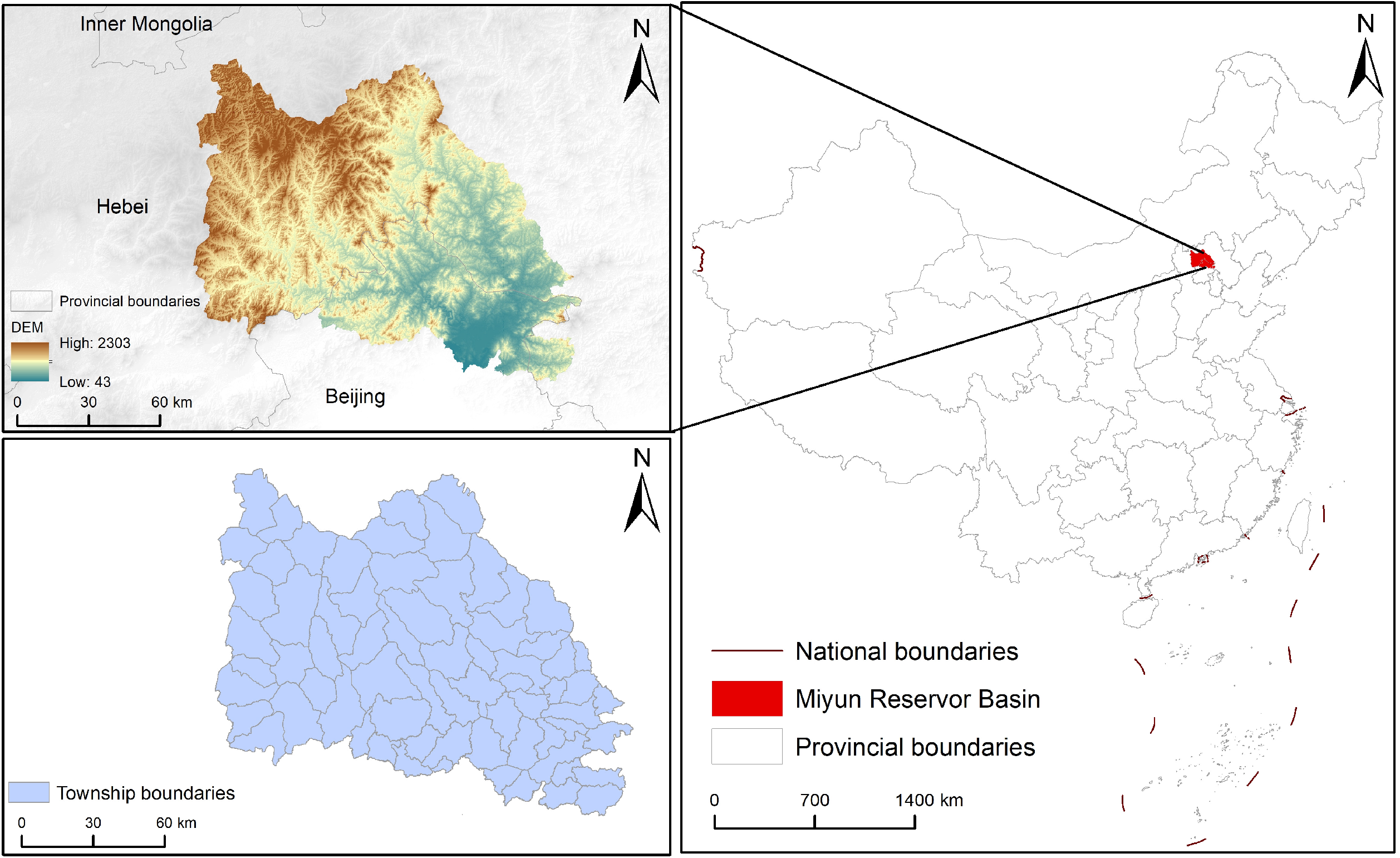
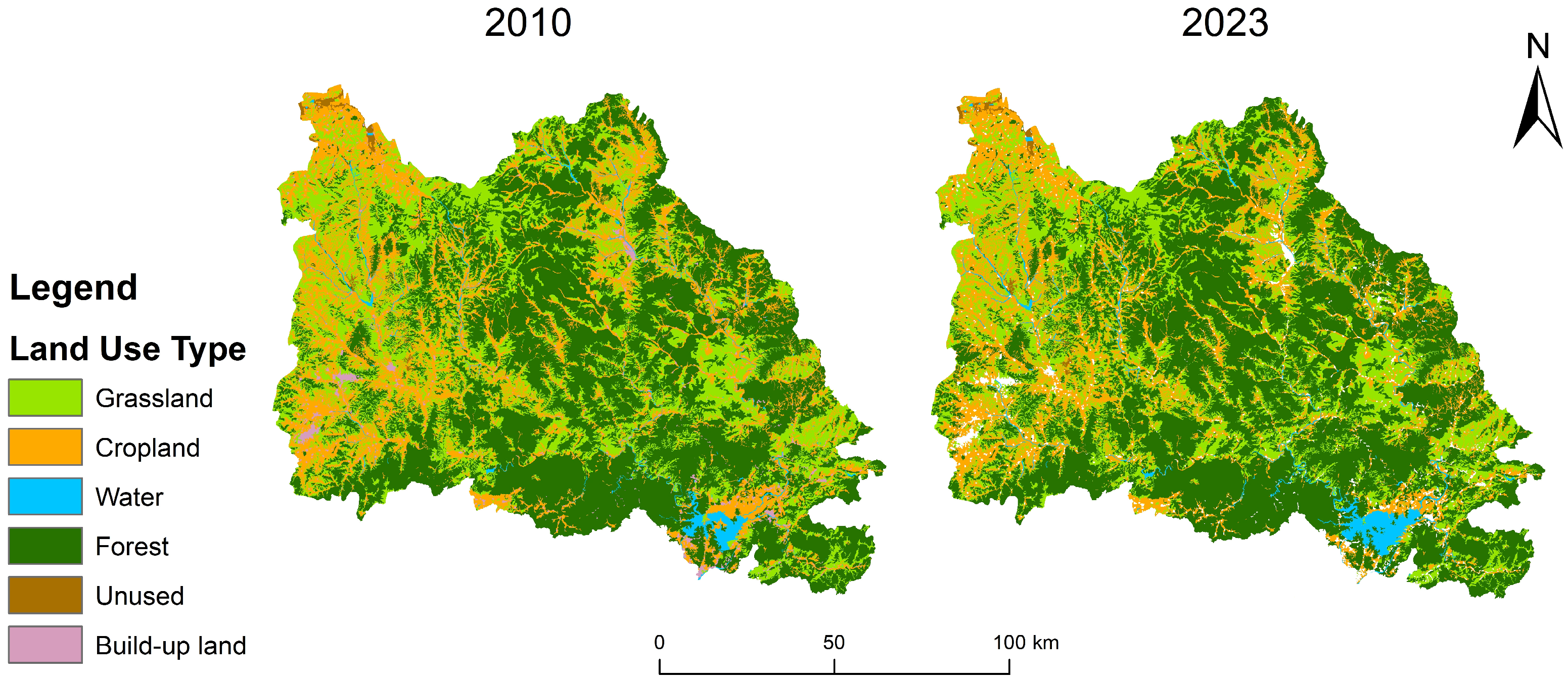
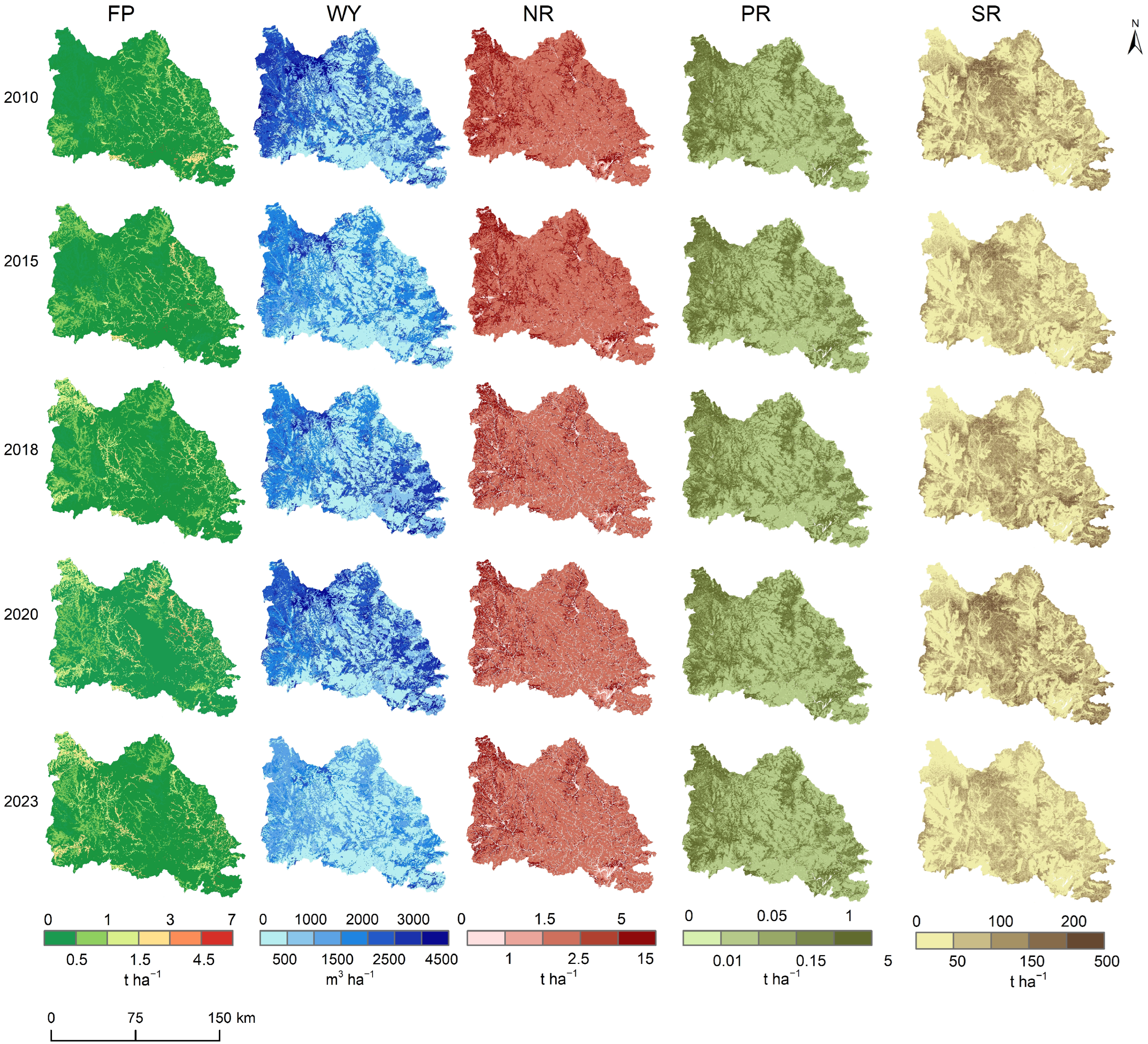
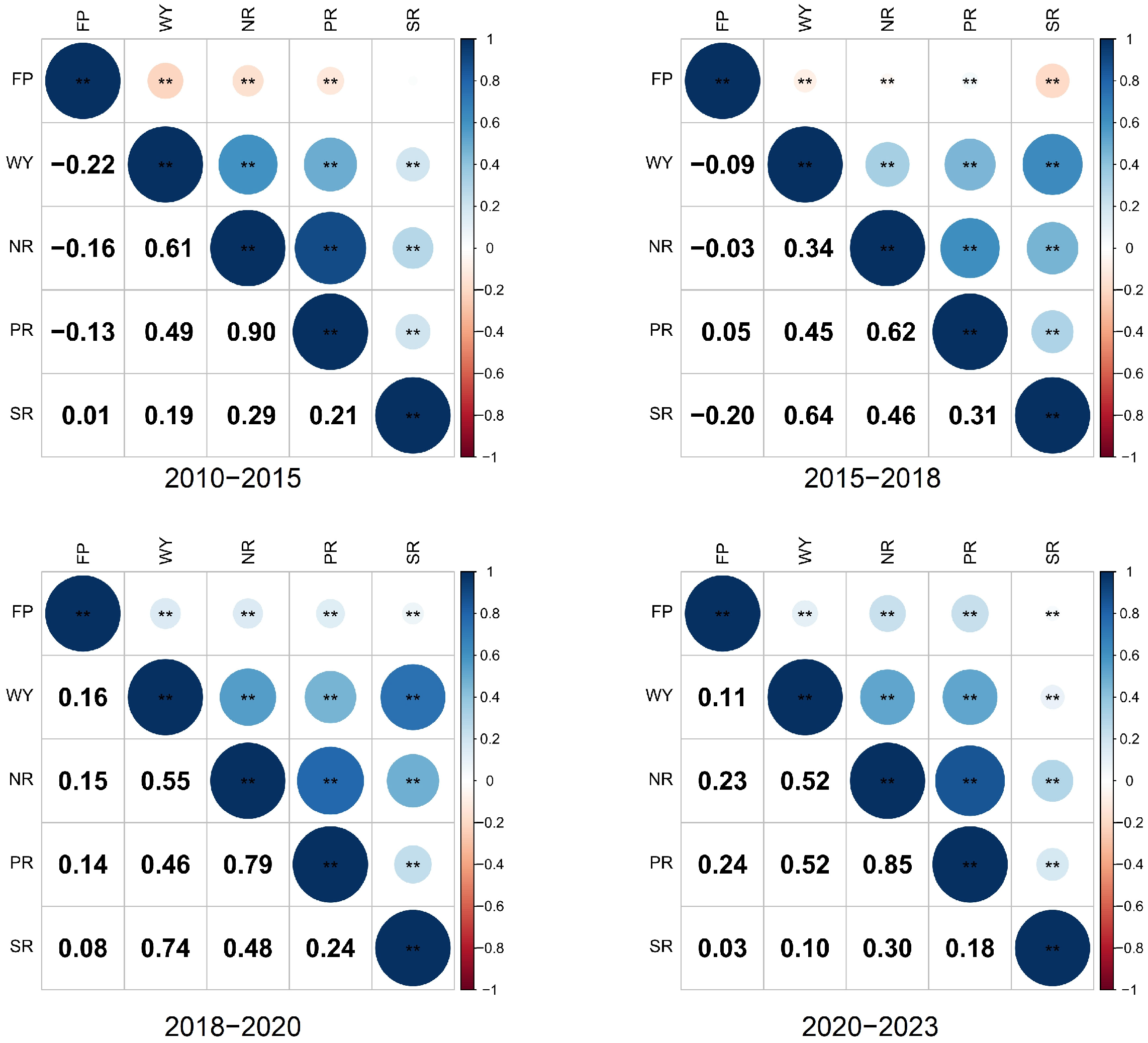
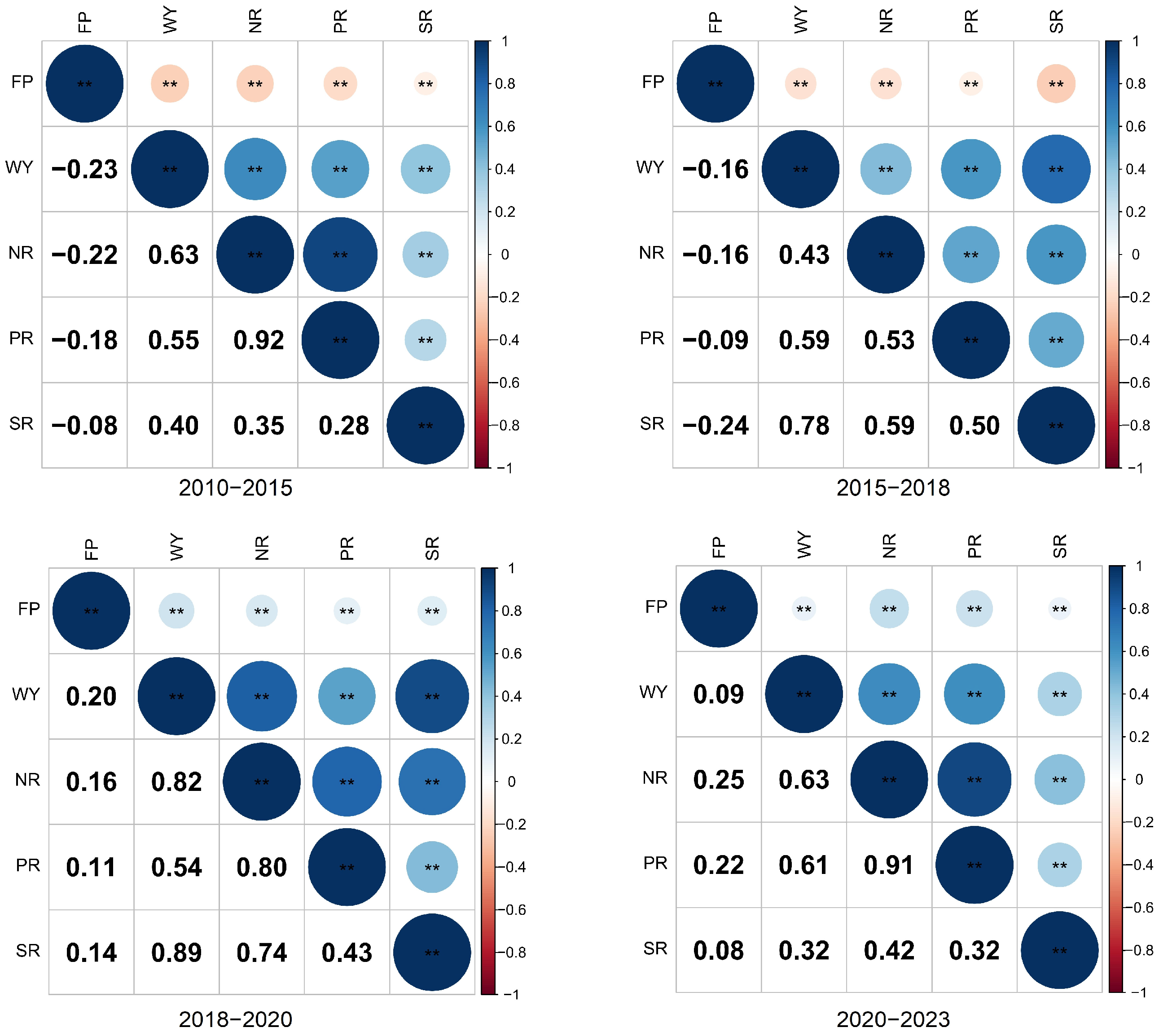
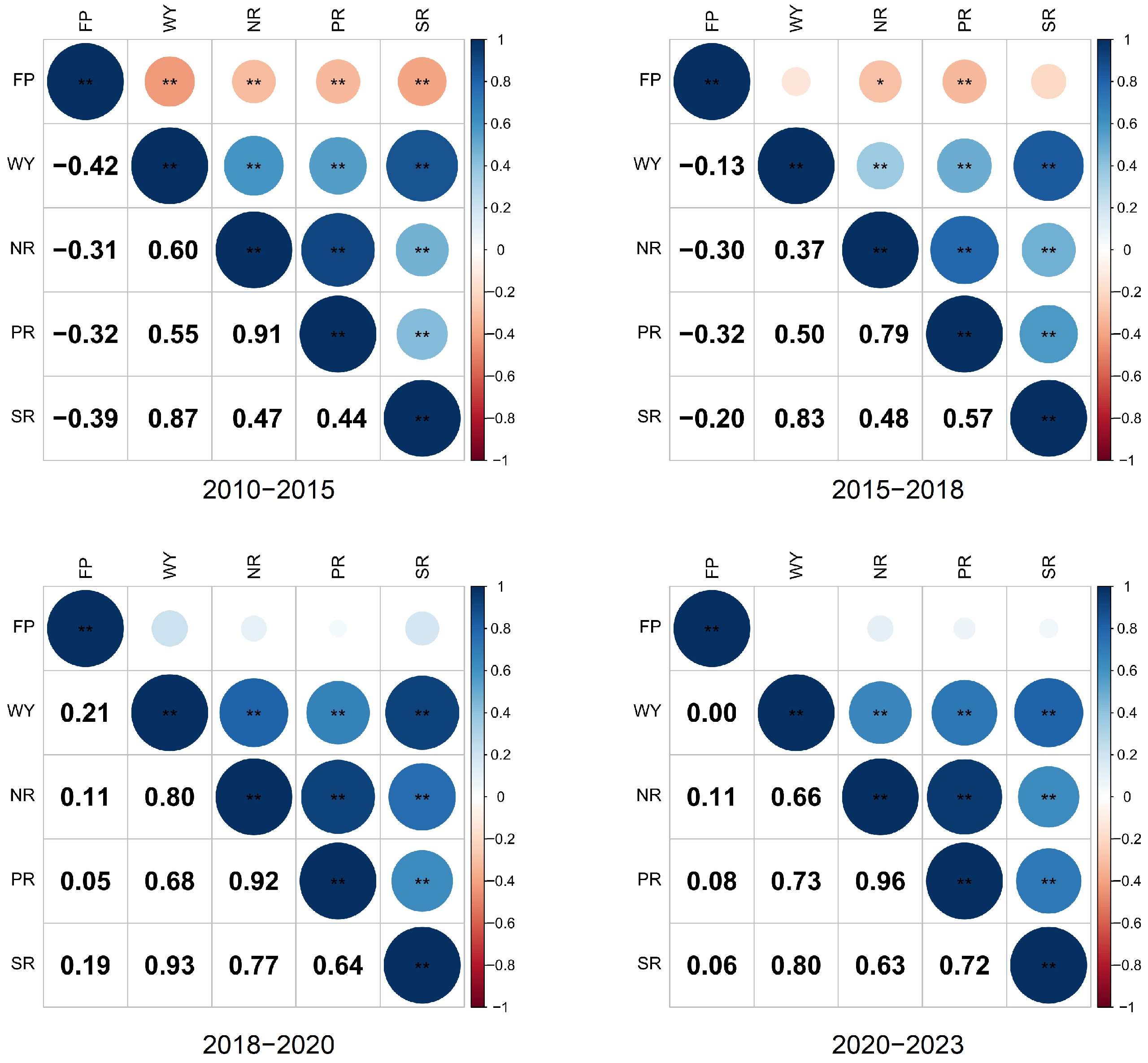
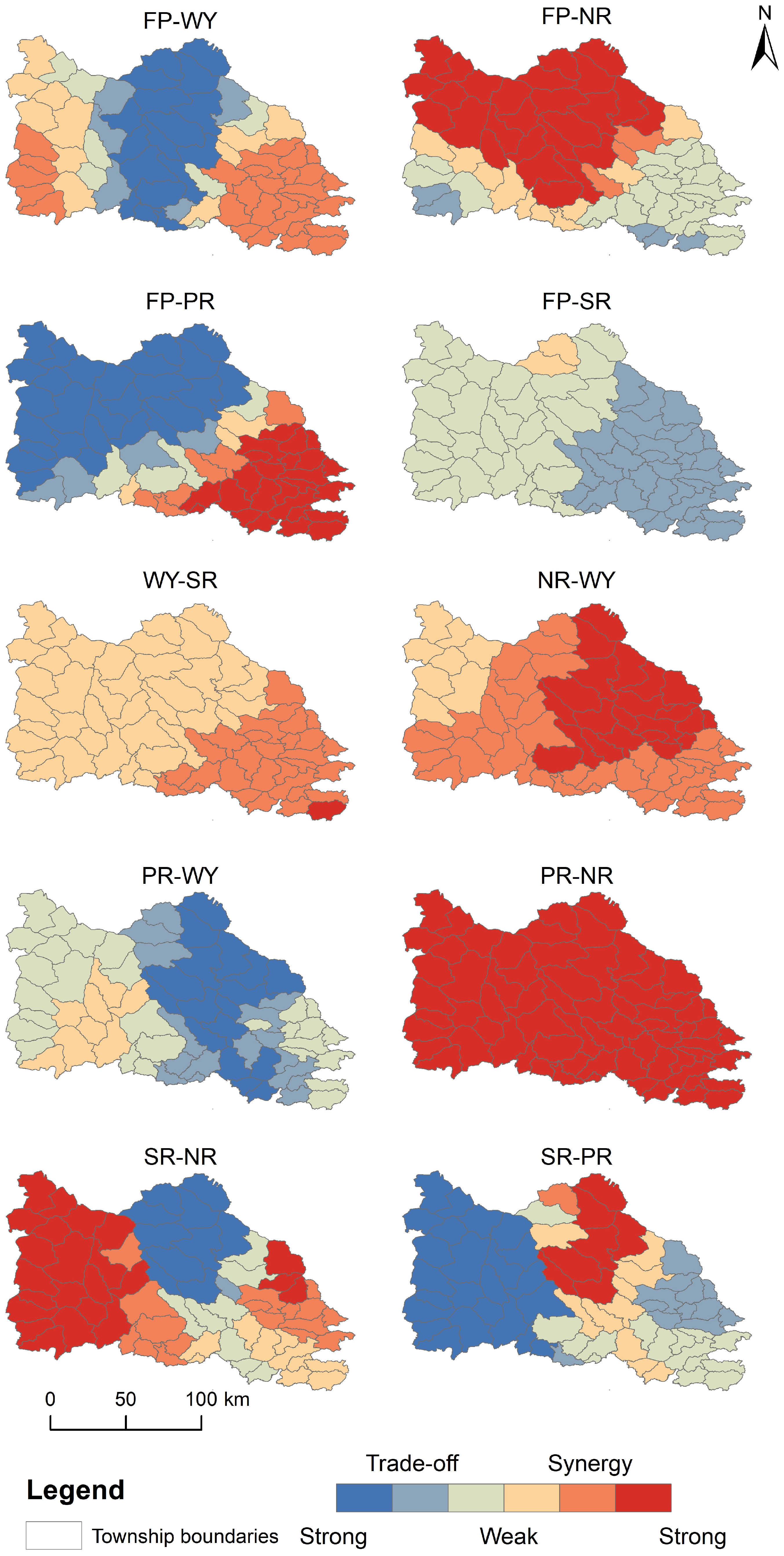
| Data Name | Format | Year | Resolution | Data Sources |
|---|---|---|---|---|
| Land Use and Land Cover | tiff | 2010, 2015, 2018, 2020, 2023 | 30 m | Resource and Environmental Science and Data Center, Chinese Academy of Sciences (https://www.resdc.cn/, accessed on 21 October 2025) |
| Precipitation and potential evapotranspiration (PET) data | CN | 2010, 2015, 2018, 2020, 2023 | —— | National Qinghai–Tibet Plateau Scientific Data Center (http://data.tpdc.ac.cn, accessed on 21 October 2025) |
| Soil depth to bedrock | tiff | —— | 1 km | Derived from published literature |
| HWSD China Soil data | tiff | —— | 1 km | Geographic Data Platform of the College of Urban and Environmental Sciences, Peking University (http://geodata.pku.edu.cn, accessed on 21 October 2025) |
| Administrative boundary vector | shp | —— | —— | Extracted from Baidu Maps |
| NDVI | tiff | 2010, 2015, 2018, 2020, 2023 | 250 m | National Qinghai–Tibet Plateau Scientific Data Center (http://data.tpdc.ac.cn, accessed on 21 October 2025) |
| Crop production data | 2010, 2015, 2018, 2020, 2023 | —— | Statistical Yearbooks of Cities and Districts/Counties | |
| Digital Elevation Model (DEM) | tiff | —— | 30 m | Derived from published literature |
| Biophysical table | —— | —— | Obtained from Invest model handbook and the literature |
| LULC Class | 2010 | 2015 | 2018 | 2020 | 2023 |
|---|---|---|---|---|---|
| Cropland | 22.41% | 22.39% | 22.07% | 22.01% | 20.72% |
| Forest | 48.02% | 47.97% | 48.27% | 48.15% | 50.18% |
| Grassland | 26.17% | 26.08% | 25.80% | 25.80% | 24.27% |
| Water | 1.41% | 1.42% | 1.59% | 1.75% | 2.10% |
| Built-up Land | 1.67% | 1.83% | 1.97% | 1.99% | 2.41% |
| Unused | 0.32% | 0.31% | 0.30% | 0.30% | 0.32% |
| 2010 | 2015 | 2018 | 2020 | 2023 | |
|---|---|---|---|---|---|
| Grain Production (t) | 287,448 | 288,831 | 330,406 | 404,932 | 363,188 |
| Water Yield (×109 m3) | 22.63 | 16.61 | 20.46 | 22.86 | 12.61 |
| Nitrogen Retention (t) | 4420.5 | 4379.8 | 4024.3 | 3991.3 | 3904.6 |
| Phosphorus Retention (t) | 723.5 | 711.6 | 700.5 | 696.9 | 665.5 |
| Soil Retention (×106 t) | 117.45 | 98.22 | 112.96 | 123.38 | 85.73 |
Disclaimer/Publisher’s Note: The statements, opinions and data contained in all publications are solely those of the individual author(s) and contributor(s) and not of MDPI and/or the editor(s). MDPI and/or the editor(s) disclaim responsibility for any injury to people or property resulting from any ideas, methods, instructions or products referred to in the content. |
© 2025 by the authors. Licensee MDPI, Basel, Switzerland. This article is an open access article distributed under the terms and conditions of the Creative Commons Attribution (CC BY) license (https://creativecommons.org/licenses/by/4.0/).
Share and Cite
Zhang, L.; Zheng, H.; Bi, J.; Zhang, X. How Ecological Compensation Reshapes Ecosystem Service Trade-Offs and Synergies: A Multi-Scale Analysis of the Miyun Reservoir Basin (2010–2023). Land 2025, 14, 2305. https://doi.org/10.3390/land14122305
Zhang L, Zheng H, Bi J, Zhang X. How Ecological Compensation Reshapes Ecosystem Service Trade-Offs and Synergies: A Multi-Scale Analysis of the Miyun Reservoir Basin (2010–2023). Land. 2025; 14(12):2305. https://doi.org/10.3390/land14122305
Chicago/Turabian StyleZhang, Liwen, Haixia Zheng, Jieying Bi, and Xuebiao Zhang. 2025. "How Ecological Compensation Reshapes Ecosystem Service Trade-Offs and Synergies: A Multi-Scale Analysis of the Miyun Reservoir Basin (2010–2023)" Land 14, no. 12: 2305. https://doi.org/10.3390/land14122305
APA StyleZhang, L., Zheng, H., Bi, J., & Zhang, X. (2025). How Ecological Compensation Reshapes Ecosystem Service Trade-Offs and Synergies: A Multi-Scale Analysis of the Miyun Reservoir Basin (2010–2023). Land, 14(12), 2305. https://doi.org/10.3390/land14122305






